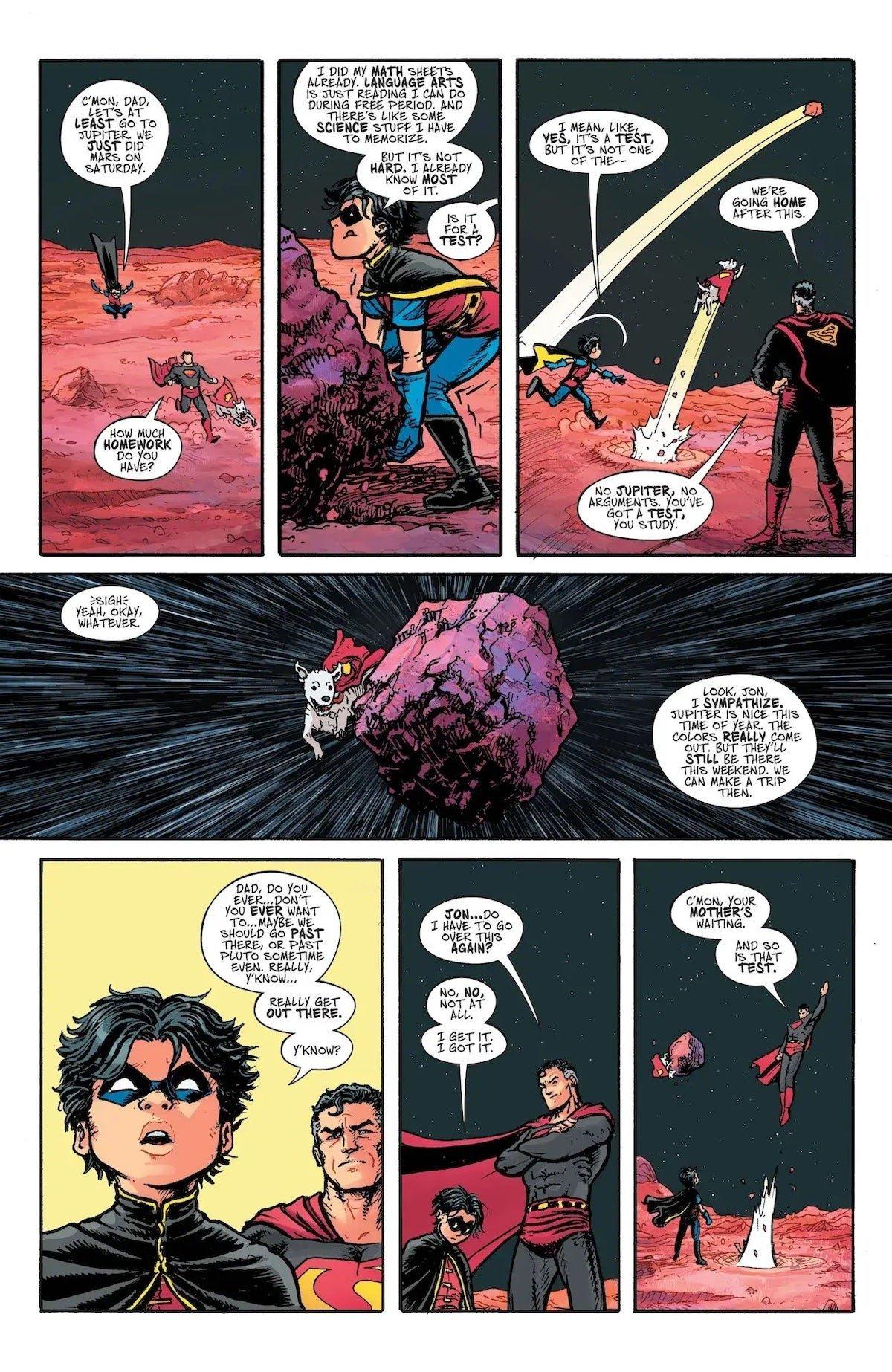If you click on a link and make a purchase we may receive a small commission. Read our editorial policy.
'Death of the Justice League'? Maybe not, as revealed in Worlds Without A Justice League: Superman this week
How a classic piece of DC comics history informs what really happened in Justice League #75 and Dark Crisis #1

When it comes to DC’s Justice League, no-one should be surprised that death is far from final. (Almost every member of the team has, by now, already died and come back to life at least once, after all.) Similarly unsurprising, then, is the realization that Justice League #75 – titled, with no small amount of melodrama, 'Death of the Justice League' – was just the beginning of the latest adventure for the World’s Greatest Super-Heroes. After teases in a number of different comics across the past year, this week’s Dark Crisis: Worlds Without A Justice League - Superman one-shot offers the biggest hints yet as to just where the Justice League have gone… and what it means that they’re there.
Spoilers for Dark Crisis, and Dark Crisis: Worlds Without A Justice League - Superman, follow. Consider this a warning.

As everyone who read Justice League #75 knows, the core team – Superman, Batman, Wonder Woman, Green Lantern John Stewart, Zatanna, Aquaman, Hawkgirl, and the Martian Manhunter – were seemingly killed by Pariah, who is attempting to use the Great Darkness to “correct” his mistake that caused the original Crisis on Infinite Earths, and give birth to a new multiverse. They weren’t alone; the Justice League Incarnate team of heroes from across the multiverse suffered a similar fate.
The visual that accompanied their deaths, though, was a telling one: recalling the death of Barry Allen in Crisis on Infinite Earths #8 way back in 1985, it showed the team – well, Superman, Batman, and Wonder Woman, at least; the others were implied to go through the same process – screaming in pain as their bodies seemingly decayed at super-speed. Except, as was established some time after the fact – initially in 1988’s Secret Origins Annual #2, and then expanded on elsewhere – Barry Allen didn’t actually die in that Crisis on Infinite Earths issue. Sure, his physical form was no more, but he lived on, nonetheless. As he put it in that Secret Origins issue: “My body’s gone… and I’ve become a creature of pure energy!!”
The same may be true of the Justice League, judging by the last couple of pages of Dark Crisis #1, which feature Pariah talking to some unseen entity while surrounded by spheres featuring, alternately, the logos of each individual Justice League member or images of each member screaming in pain. (Those screaming heroes, by the way, include Black Canary and Green Arrow, two characters who noticeably weren’t seen killed by Pariah in Justice League #75 – in fact, it was implied that Doomsday had killed Green Arrow entirely separately earlier in the issue.)

The Justice League, then, might not be as dead as it looked… but, instead, they might be transformed into pure energy, and then stored in some form of sphere. To be fair, in superhero comics, I’m pretty sure that this is something that counts as a regular occupational hazard.
Where Dark Crisis: Worlds Without A Justice League - Superman builds on all of this, though, is giving fans a better idea as to what’s actually happening inside those spheres – and, in the process, offering some clue as to where Barry Allen has been since last year’s Infinite Frontier miniseries, as well.
The two stories in the issue – 'Out There,' by Tom King, Chris Burnham, and Adriano Lucas, and 'Aquaman Has Everything,' by Brandon Thomas, Fico Ossio, and Sebastian Cheng – are, on the surface, wish-fulfillment stories for both heroes… but ones that are, to put it mildly, somewhat flawed. 'Out There' shows a Clark Kent somewhat at odds with his rebellious son Jonathan, who wonders why his father isn’t more proactive in protecting life beyond the Earth’s atmosphere; 'Aquaman Has Everything' is, initially, more uplifting and positive as it shows a series of happy endings and loving relationships for those surrounding the errant King of Atlantis, but it’s not something he can bring himself to believe in.
In both cases, the hero is being given what others might believe they really want – Superman even tells Lois in the world he’s in, “I was there, Lois. I was here. I saw him. I got to see him grow into the man he had to be. I didn’t miss it this time,” referencing the fact that, thanks to time travel shenanigans and the intervention of his own father, Clark missed watching Jon go from a child to a late teen – in an attempt to keep them placid and unlikely to fight back against whatever is going on… but, in both cases, it doesn’t really seem to be working out too well.

Clark is, obviously, pained by Jon’s rebelliousness and constant questioning of the rules he’s living under. Aquaman, meanwhile, is more openly contemptuous of the reality he’s living in. “I don’t have everything yet,” he tells an unseen foe at the story’s end. “I don’t yet have my hands around your throat. You think you’ve beaten us – but better than you have tried, and in the end, you all learn… not even death will hold us. I’ve been dead before, and I’ve come back.”
Notably, neither story features an appearance by any other Justice League member, as if they’re being kept apart from each other for some reason (Hi, Pariah)... but both make oblique references to teammates, nonetheless: Jon Kent’s teenage superhero outfit is, to all intents and purposes, Robin’s costume, while Aquaman’s daughter’s girlfriend shows up in his story… and it’s Jess Chambers, the Flash of Earth-11 – who’s also the Flash of the current Multiversity: Teen Justice series. It’s almost as if it’s difficult to keep the Justice League out of each heroes’ heads, no matter how hard you try.
So what does this have to do with Barry Allen, you might ask? Well, for that, you have to go back to the two series that led up to Dark Crisis over the last year. At the end of the Infinite Frontier series, Dark Crisis writer Joshua Williamson and artist Xermánico show the Flash being killed by Pariah – with a visual effect identical to the deaths of the Justice League in JL #75 – before finding himself in an idyllic family dinner on what’s identified as "Earth-Flash.1." The Justice League Incarnate visit Earth-Flash.1 in the final issue of Justice League Incarnate, only to discover a Barry Allen who’s bought into the happy life he’s been offered before being thrown back into 'reality' by Pariah. (Williamson co-writes the issue with Dennis Culver, and Andrei Bressan, Jesús Merino, and Hi-Fi provide visuals.)

What’s happened to Barry Allen, then, seems a successful variation on what’s happened to the rest of the Justice League with apparently lesser degrees of progress. We haven’t seen any official identification of “Earth-Superman.1,” “Earth-Aquaman.1,” or similarly named realities, and we haven’t seen any Flash-labeled sphere just yet… but it’s only a matter of time. In the crazy world of comic book canon, it’s almost ridiculous to count anything as canon until it’s definitively spelled out on the page, but as things currently stand, it certainly looks as if the Justice League isn’t as dead as everyone on DC’s Earth-Zero believes… and, more to the point, they’re potentially ready to be rescued, should anyone have the multiverse-traveling skills to make it happen.
Expect things to get worse – especially for the heroes trapped in their own pocket planets – before they get better, however.
Continue to follow Dark Crisis through the end of the year, including four more issues of Worlds Without A Justice League.
How green Is your Riddler? An look at Tom King and Mitch Gerads’ upcoming graphic novel from DC
Follow Popverse for upcoming event coverage and news
Find out how we conduct our review by reading our review policy
Let Popverse be your tour guide through the wilderness of pop culture
Sign in and let us help you find your new favorite thing.
















Comments
Want to join the discussion? Please activate your account first.
Visit Reedpop ID if you need to resend the confirmation email.